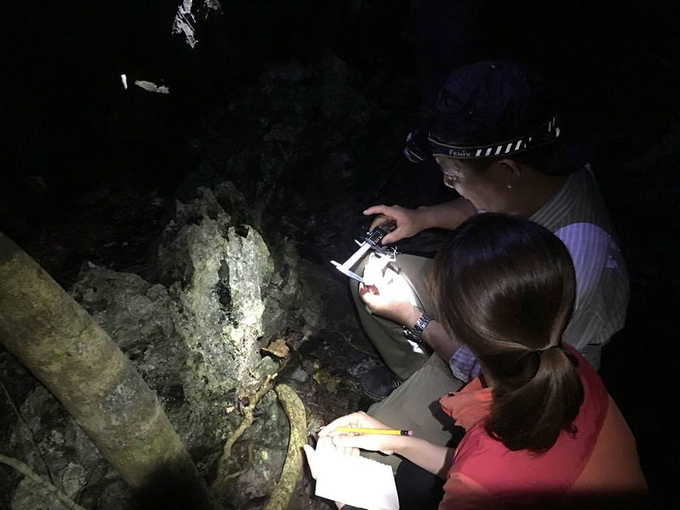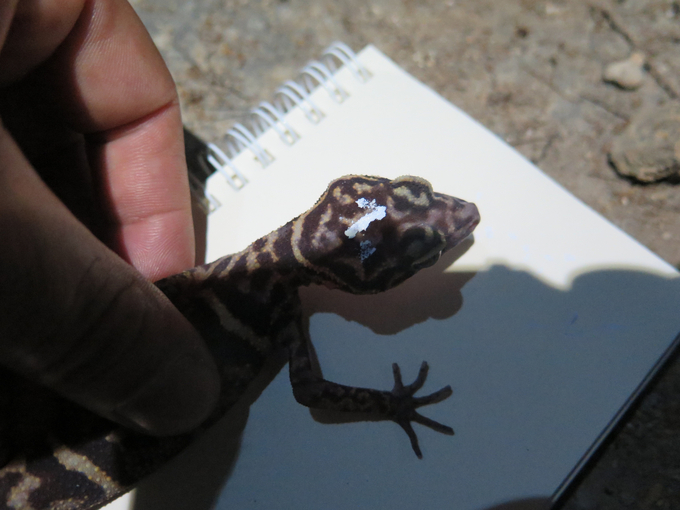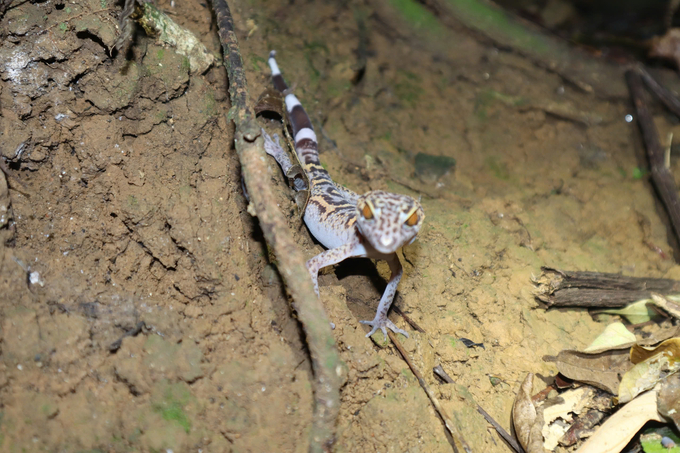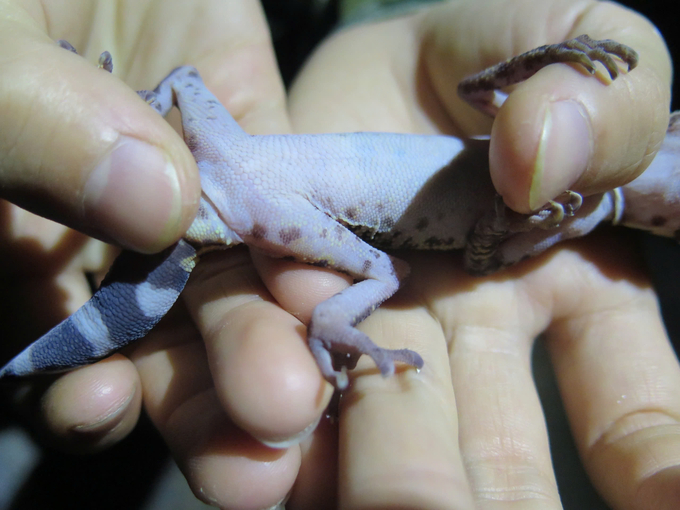February 4, 2025 | 21:08 GMT +7
February 4, 2025 | 21:08 GMT +7
Hotline: 0913.378.918
February 4, 2025 | 21:08 GMT +7
Hotline: 0913.378.918

Experts record an adult Cat Ba tiger gecko at a rocky cave in Cat Ba National Park. Photo: Dinh Muoi.
The Cat Ba tiger gecko, one of the rare endemic species of Cat Ba National Park, was discovered and announced in 2008. Initially, this reptile was only found in the Cat Ba Biosphere Reserve (Hai Phong city), but recent studies show that the species is more widespread, appearing on smaller islands in Ha Long Bay (Quang Ninh province).

The individuals found are carefully marked before being released back into the wild. Photo: Dinh Muoi.
The Cat Ba tiger gecko has a distinctive appearance with a slender, flat body measuring 84-111 mm in length. Its back is brown with alternating gray patches and yellow spots along the sides. They live in rock crevices and caves on cliff faces, with a limited distribution area and a small population.
The species' endangered status was recognized when it was listed as endangered in the IUCN Red List in 2016. In 2019, it was included in the Government Decree on the “Management of rare and precious forest plants and animals” and the enforcement of the Convention on International Trade in Endangered Species of Wild Fauna and Flora (CITES).

Cat Ba tiger gecko has a slender, flat body, 84-111mm in length, with a brown back marked with gray patches and yellow spots along the sides. Photo: Dinh Muoi.
To protect this rare species, Cat Ba National Park has conducted research and proposed conservation measures in recent years. The Park has identified the population’s current status, ecological and biological characteristics, assessed threats, and suggested effective protection solutions.
Specifically, the research team conducted 15 surveys in various areas and recorded the presence of 548 individuals, mainly distributed in five locations: the forest around the National Park headquarters, the areas of Gio Cung, Ang Ke, Viet Hai, Tra Bau, and Dau Be.
According to Master Pham Van Thuong, the project leader, the Cat Ba Bent-Toed Gecko is primarily found on limestone cliffs, with a few recorded on soil, dry tree roots, and branches on the ground. Adult and sub-adult individuals tend to choose higher positions compared to juveniles, but there is no significant difference in height preference among age groups.
The Cat Ba tiger gecko is mostly found outside caves, breeds in the summer from May to August, and primarily feeds on worms, insects, dry branches, and cockroaches. It is typically observed from March to October each year, with population numbers increasing from April to August, peaking between May and August.
The gecko is most active during hot or humid weather, especially after rain, and less active during cold or heavy rain periods, such as after storms. Its range of activity is narrow, and it tends to return to the same spots.
According to Mr. Thuong, the Cat Ba tiger gecko's attractive appearance has made it a target for illegal hunting, being kept as exotic pets or sold abroad. This practice is severely affecting the species' survival in the wild.
“This is one of 21 endemic species in Cat Ba National Park, with great significance, characteristic of the limestone ecosystem of Cat Ba. It is a valuable genetic resource, playing a crucial role in maintaining the biodiversity of the Cat Ba Archipelago. Protecting this reptile is everyone's responsibility, contributing to the conservation of the unique and precious ecosystem of this land,” said Mr. Thuong.
According to Cat Ba National Park officials, given the limited number of Cat Ba tiger gecko, protecting the genetic resources in these areas is crucial. Currently, there are five main factors negatively impacting the species' population and habitat: illegal hunting, trade, usage, climate change, uncontrolled tourism development, and habitat destruction.

The number of Cat Ba tiger gecko is very low, making the protection of genetic resources in these areas extremely necessary. Photo: Dinh Muoi.
To protect the Cat Ba tiger gecko, the park's Conservation and International Cooperation Department has been tasked with continuing research on the species' characteristics and behavior. Experimental breeding of some pairs has been initiated to study the species more closely and to help restore its population. There is also a focus on protecting their natural habitat.
Additionally, management measures have been proposed to preserve and enhance the ecosystem's value, with immediate actions to intensify monitoring and protection of the species and its habitat.
Local authorities in relevant areas must control the negative impacts of tourism, manage waste collection, minimize the use of fires, incense, and lights in tourist caves where the Cat Ba tiger gecko resides.
Moreover, night-time outdoor activities should be restricted, as should noise from singing and dining at homestays near the caves.
For the local population, it is crucial to raise awareness about minimizing hunting and using wild animals, especially in buffer zones, and to strictly control the negative impacts of tourism, such as littering, fire usage, noise, and activities that could disturb the habitat of this rare species.
“Protecting Cat Ba tiger gecko is an urgent task requiring the community's joint effort. In addition to the aforementioned solutions, future research on artificial breeding methods is needed to sustain the species for future generations. The combination of scientific research and conservation measures is critical to preserving the Cat Ba tiger gecko and maintaining the unique biodiversity of Cat Ba for future generations,” said Nguyen Van Thieu, Director of Cat Ba National Park.
Translated by Kieu Chi

(VAN) US president says he will hit Canada, Mexico, China and EU with levies as he targets major trading partners.

(VAN) A research study of bird flu viruses in cattle has shown that the H5N1 strain does not pose an increased threat to humans.

(VAN) In two actions, migrant workers claim exploitation while farmers demonstrate against inheritance tax plan.

(VAN) From FAO Regional Office for Near East and North Africa.

(VAN) President of the Czech Republic Petr Pavel affirmed his support for the EC to consider lifting the IUU 'yellow card' on Vietnam's seafood exports.

(VAN) Discover how a genetic mutation in plants enhances partnerships with soil microbes, reducing fertilizer use and boosting sustainable farming practices.

(VAN) This is the result after 5 years of implementing the project, which was carried out by the Ministry of Natural Resources and Environment in collaboration with the United Nations Development Programme (UNDP).